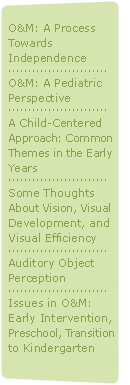|

|
O&M:
A Pediatric Perspective
by
Joe Cutter
Historically,
orientation and mobility has been taught from adult
to adult with particular emphasis on cane travel as
the beginning of instruction. This tradition can be
referred to as a "top-down*" approach, adults already
having the concepts and learning new motor schemes to
match their comprehension.
With
a pediatric perspective, however, the approach will
be "bottom-up."* First the child learns purposeful
movement, and out of the relied-upon motor schemes will
come the concepts. During these early years, the blind
child will come to know and move in his/her environment
with a greater or lesser degree of competency. The orientation
and mobility specialist can have a significant positive
impact on the blind child's development.
The
0&M specialist working with young blind children will
function as a "mobility architect," analyzing related
needs of the child, working with the parents, school
(early intervention, preschool, kindergarten) and designing
strategies that will assist in preparing the child for
present and future independent travel. The 0&M specialist's
role may fluctuate between consultant, demonstrator,
and ongoing instructor. Of particular importance will
be providing parents with clear, accurate information
and helping them to "read" their child's signals. This
attunement between parent and child will be the foundation
for getting to know and be in the world. The O&M specialist
will evaluate what is available to the child and assist
the parents and school in helping the child "take it
all in."
In
partnership with parents, the O&M specialist will explore
strate-gies, activities, and tools to facilitate purposeful
thought and pur-poseful movement. By being more aware
of the "menu," we will feed blind children experiences
(adaptive techniques, etc.) that will make sense to
them. In this way, the more natural course and intent
of maturation may unfold over time. In this way, for
example, cane travel will not be viewed as an isolated
set of skills, but as part of a process: a continuation
of learning manipulative skills. The spoon, then, becomes
the precursor to the cane. Tools used to manage "space"
and get tasks done (spoons, scoops, shovels, brooms,
etc.) will be respected in this "bottom-up" approach.
The alternative techniques of blindness will be thought
out and applied from infancy to adulthood. The 0&M specialist
will be cautious not to prematurely insist upon "proper"
techniques, as this may interrupt the young child's
need to explore, figure it out, and develop his/her
own useful self-taught solutions.
I
believe that as human beings, blind children have a
sense of order, a sense of organizing their experiences,
and the ability to improve upon the experiences AS ALL
CHILDREN DO! I
believe in the interconnectiveness of the sensory systems,
that vision is only one system and that blind children
have a multitude of systems available to them (touch,
auditory, vestibular, proprioceptive, smell, taste,
the drive to move, the need to know, the ability to
self-amuse, etc.). We must invite the blind child to
make the world their home; to move safely, confidently,
and effectively, and to demonstrate the kind of strength,
wisdom, and poise that is within them.
*
"Top-down" and "bottom-up" as introduced by Dr. Lorraine
McCune in her Infant Studies courses at Rutgers University.

|

